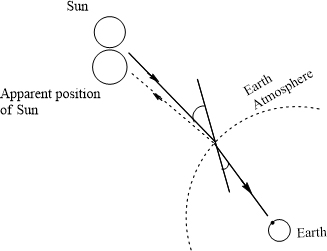
Concept explainers
(a) To Explain:
That Light rays from stars (including our sun)always bend towards the vertical direction as they pass through the Earth’s atmosphere
Answer to Problem 19Q
Solution:
When light rays from stars (including our sun)enter from vacuum (lower refractive index medium)to our atmosphere (higher refractive index medium), then
Explanation of Solution
The light rays, coming from the stars and sun travelling through the vacuum and enter the Earth atmosphere. The refractive index of the vacuum is lower than the refractive index of the Earth Atmosphere.
From the Snell’s law
The velocity of the light is slower and hence the refractive index of the medium is high, as given by the equation
Where
Also from the equation,
Where
At the boundary of the Earth atmosphere, as the light rays enter the Earth atmosphere of high refractive index, the angle of refraction is low and so the rays are bent toward the normal and the refracted rays are only observed by the observers at Earth.
(b) To determine:
The apparent positions of stars as viewed from Earth if Light rays from stars (including our sun)always bend toward the vertical direction as they pass through the Earth’s atmosphere
Answer to Problem 19Q
Solution:
When light rays enter from vacuum (lower refractive index medium)to our atmosphere (higher refractive index medium), as per Snell's law the light rays are bent towards the vertical direction.
As the observers sitting on Earth can see the refracted light rays, they interpret that they are seeing the image of the Sun and the stars appear to come from the apparent position as depicted by the figure.
As light rays come from very far away distance and the distances of the objects are too high, the apparent position of the Sun and stars cannot be practically predicted.
Explanation of Solution
The Sun and the stars that are viewed by the observers on Earth are the apparent position of the Sun and the stars. Because, the observer can see the refracted light rays from the Sun and the Star
As the light rays are come from the vacuum and enters the air atmosphere and it undergo refraction at the boundary of the earth atmosphere.
These refracted rays are viewed by the earth observer and hence they are viewing the image of the Sun and the stars, which are the apparent position.
The situation is depicted by the figure below.

But, the apparent location of the Sun and star, cannot determined as the object are situated at very far distance, the observe cannot predict that the position of the Sun and the star, whether it is above or below or sideways of the real objects, that the position with respect to the real object is beyond the knowledge of the observer.
Chapter 23 Solutions
Physics: Principles with Applications
Additional Science Textbook Solutions
College Physics
University Physics with Modern Physics (14th Edition)
The Cosmic Perspective Fundamentals (2nd Edition)
Modern Physics
The Cosmic Perspective (8th Edition)
Sears And Zemansky's University Physics With Modern Physics
 College PhysicsPhysicsISBN:9781305952300Author:Raymond A. Serway, Chris VuillePublisher:Cengage Learning
College PhysicsPhysicsISBN:9781305952300Author:Raymond A. Serway, Chris VuillePublisher:Cengage Learning University Physics (14th Edition)PhysicsISBN:9780133969290Author:Hugh D. Young, Roger A. FreedmanPublisher:PEARSON
University Physics (14th Edition)PhysicsISBN:9780133969290Author:Hugh D. Young, Roger A. FreedmanPublisher:PEARSON Introduction To Quantum MechanicsPhysicsISBN:9781107189638Author:Griffiths, David J., Schroeter, Darrell F.Publisher:Cambridge University Press
Introduction To Quantum MechanicsPhysicsISBN:9781107189638Author:Griffiths, David J., Schroeter, Darrell F.Publisher:Cambridge University Press Physics for Scientists and EngineersPhysicsISBN:9781337553278Author:Raymond A. Serway, John W. JewettPublisher:Cengage Learning
Physics for Scientists and EngineersPhysicsISBN:9781337553278Author:Raymond A. Serway, John W. JewettPublisher:Cengage Learning Lecture- Tutorials for Introductory AstronomyPhysicsISBN:9780321820464Author:Edward E. Prather, Tim P. Slater, Jeff P. Adams, Gina BrissendenPublisher:Addison-Wesley
Lecture- Tutorials for Introductory AstronomyPhysicsISBN:9780321820464Author:Edward E. Prather, Tim P. Slater, Jeff P. Adams, Gina BrissendenPublisher:Addison-Wesley College Physics: A Strategic Approach (4th Editio...PhysicsISBN:9780134609034Author:Randall D. Knight (Professor Emeritus), Brian Jones, Stuart FieldPublisher:PEARSON
College Physics: A Strategic Approach (4th Editio...PhysicsISBN:9780134609034Author:Randall D. Knight (Professor Emeritus), Brian Jones, Stuart FieldPublisher:PEARSON





